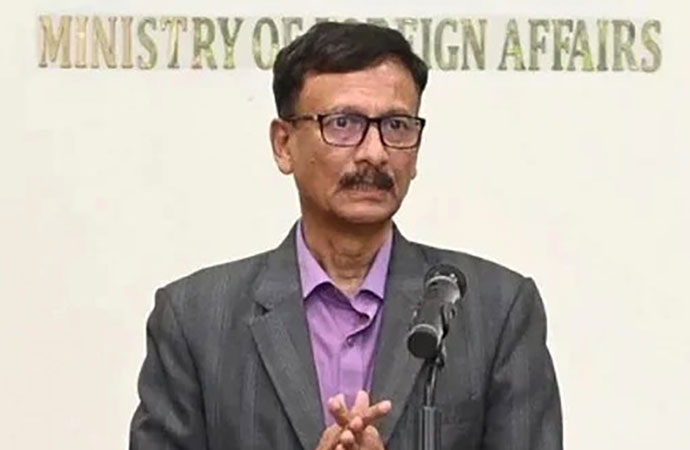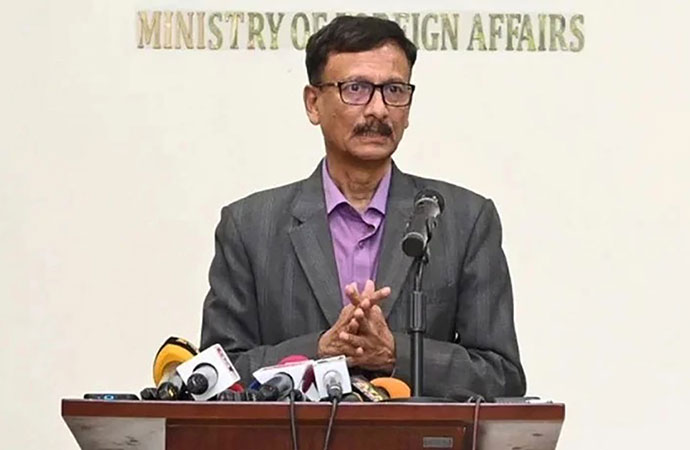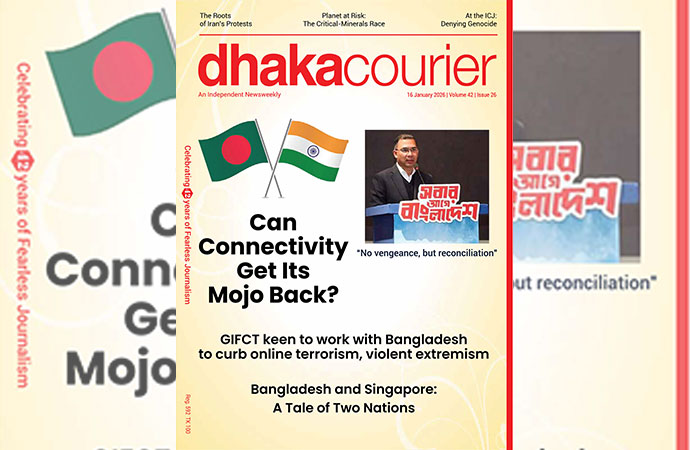Reportage

From left Author and Historical Researcher Raana Haider, Founder Trustee of Liberation War Museum Mofidul Hoque, Executive Director of Cosmos Foundation Nahar Khan, Archivist-Schoiar Dr Kenneth X. Robbins, John Evans Distinguished University Professor of University of Denver Prof Haider Ali Khan and Journalist Afsan Chowdhury. Photo: UNB
Dr Kenneth X Robbins says at Cosmos Foundation’s Distinguished Speaker Series event
Exploring the Afro-South Asia connection and the untold narratives of the Habshi rulers during the Sultanate period in Bengal, globally renowned researcher, archivist and curator Dr Kenneth X Robbins on Tuesday said that the historic ties between the Afro-South Asian communities need to be closely studied across the globe.
"Africans were an integral part of several Indian Sultanates, and some even started their own dynasties after moving to South Asia and eventually settled down here to play an essential role in the Indian subcontinent's history of kingdoms, conquests and wars. They made contributions to this region's history as soldiers and mercenaries, traders and merchants, musicians, scholars, and even generals and rulers," Dr Robbins said.
They flourished as traders, artists, rulers, architects and reformers between the 14th and 17th centuries, and many Bengalis, on the other hand, also settled in Africa. These histories are lesser known, which is why it is necessary to bring global attention to the Afro-South Asian relationship and the Habshi dynasties, according to Dr Robbins who used his collections to publish fourteen books on South Asian history and culture, rooted from his special interests ranging from maharajas, nawabs, and Deccani sultans to minority groups like Afro-South Asians.
Cosmos Foundation, the philanthropic arm of the Cosmos Group, hosted the symposium and exhibition featuring Dr Kenneth X Robbins as part of its Distinguished Speaker Series, titled "Afro-South Asia Connectivity and the Habshi Kingdoms of Bengal and Beyond" on January 3 at the Garden Gallery, Baridhara in Dhaka.
The welcome remarks were delivered by Nahar Khan, Executive Director of Cosmos Foundation, followed by the keynote speech of Dr Robbins, who is currently on a visit to Bangladesh with his wife Joyce Robbins.
"Many of us have heard of Indians in Africa. However, the movement of people across the Indian Ocean from Africa to India, the fascinating historical exchanges in knowledge, music, arts and culture still remain quite unfamiliar to us. Great lessons can be drawn from the history of how our cultures were shaped by one another, and in many ways still continue to do so. Much thanks to the pioneering work of our distinguished speaker, archivist and scholar Dr Kenneth Robbins in this regard, who has curated several Indian exhibits and many scholarly conferences," Nahar Khan said in her welcome remarks.
She mentioned that in addition to publishing more than 70 articles, Dr Robbins coedited a three-volume series on Afro-South Asia in the global African diaspora. "These are the most comprehensive accounts of the experiences of the African diaspora in South Asia, which gives us an enthralling insight into the role of Africans in shaping South Asian history, and the interactions between the two communities," she said.
A voracious collector, Dr Robbins began collecting Rajput, Deccani, Mughal and other paintings from dealers and auction houses in the 1960s. Struck by the fact that only coin collectors knew that Bengal was once ruled by an East African dynasty - from 1486 to 1493, he made it his life's mission to bring such information into general public discourse.
In October, it was revealed that the Robbins family has designated the Pen Library - the library system of the University of Pennsylvania, an IVY League school in the US, as the recipient of their entire collection in their estate planning.
"The generosity of the Robbins family means generations of scholars will find research topics here and use these materials in their teaching - which will bring such information to textbooks in schools and into the general historical discussion. That to me is the meaning and spirit of true scholarship, and I am also happy to announce that we have been working on a book and a film project on Africans in Bengal," Nahar Khan said.
During his keynote presentation, Dr Robbins showcased and described some of the significant images from his personal collections. He discussed the cover photographs and background history of two of his recently co-authored books: 'African Rulers and Generals in India' and 'Four People of the Book: From Foreign Jewish Roots to South Asian Islamic Roles'.
Dr Robbins mentioned Muslims and Islam in South Asia through paintings, how African Muslims received and explored subcontinental cultures in practice; the interrelation of Judaism, Christianity and Islam; 18th century paintings of Deccani birds; the story of 'Matsyendranath: The Yogi as Sufi Bijapur during the third quarter of 17th century'; Muharram in Patna, Bengal and Bihar; the Holi festival in the palace at Murshidabad; and other significant images. He also mentioned two important names while referencing the cultural ties between the Africans and the Bengals.
"Nawab Sidi Ibrahim Muhammad Yakut Khan III of the Sachin state had a long-term relationship with a non-African Muslim woman named Fatima who was one of the pioneering directors-actresses in Indian movies made in the 1920s and often considered the first female film director in Indian cinema. Their daughter was Zubeida, who acted in India's first-ever film with sound 'Alam Ara' and in the photographs and paintings on her films, she appeared to be a white woman - whether she was romancing a white hero or menaced by a dark villain in blackface. This construction of racism and colourism is really a very important part of Indian and South Asian history."
He showcased a photograph of Tim Mo Cre, Bardu Ali, Blue McAllister and George Williams - four African American entertainers - among whom Bardu Ali had a Bengali Muslim father. "This is more than 100 years ago, people coming from the Bengal and settling in the United States," Dr Robbins said.
Dr Robbins concluded, "I think the importance of what is Nahar proposing that we do, is to give the history a bit of interaction between the people of African origin and Bengal across the globe - not only in Bangladesh or Kolkata or Murshidabad but also in places like South Africa within its Bengali community."
Alongside the insightful keynote presentation of Dr Robbins, a panel discussion was held featuring a prolific set of distinguished scholars including Mofidul Hoque, founder trustee of the Liberation War Museum; Afsan Chowdhury, researcher-academician and Editor-at-Large of United News of Bangladesh (UNB); and Raana Haider, a globally renowned author and historical researcher.
"History tells us that Europe covered and ruled this area with the help of power, warfare and commerce but Africans came here as slaves and soldiers. They received Islam, embraced Bengal and become part of our culture," Mofidul Hoque said at the discussion.
He added, "The relationship between the Bengalis and the Africans is not highlighted in history because of the mentioning of slavery. Not only the Africans came to Bengal as slaves, but the people in Bengal were also going to Africa as labourers. In his stage play 'Haat-Hadai', late-popular dramatist Selim Al Deen narrated the history of a sailor who travelled to Africa by ocean."
The exhibition in the symposium showcased a selection of items from the Kenneth and Joyce Robbins collection on South Asian history, described as the largest collection outside of India. Their collection comprises more than 100,000 items including books, manuscripts, medals and fine artworks - speaking to the diverse cultures and traditions that find expression in India.
Lauding the keynote presentation of Dr Kenneth Robbins and the exhibition, researcher-scholar Afsan Chowdhury said that literature, art and history can transcend borders and time, and make people feel connected with history. "An African became a Nawab in this region and started a dynasty, ruled for six years - and we can trace them because of the historic artefacts like these."
Connecting the struggle stories of people from history, Afsan Chowdhury said, "Most of the history could not get written because of the unavailability of source materials. Even with our Liberation War, the history of the mass people has vanished. We only talk about politicians and soldiers and their sacrifices while the history of the mass people, despite being significant, is largely missing."
Raana Haider said that there were several Habshi rulers in Bengal and although their history is not known by all, their impact was timeless. "Africans came here and made contributions to this region's history as soldiers and mercenaries, traders and merchants, musicians, scholars, and even generals and rulers. Their history has been mentioned in Bengali art and literature. Their food is also here, such as the 'Habshi Halwa', a very popular sweet dish in this region. The word 'Habshi' translates as 'dark' or the colour 'black', and the recipe originated from the royal kitchens of the Habshi dynasty. Sadly, many people do not know the origin story because the Africans were mostly described as slaves."
The panel discussion was followed by the concluding remarks of Prof Haider Ali Khan, John Evans Distinguished Professor at the University of Denver, who said that rediscovering and interpreting art is a significant part of history, and he lauded Cosmos Foundation and Dr Kenneth Robbins for the symposium and exhibition on the Afro-South Asia connectivity.
"Art history is also people's history, and we must research to know the cultural realities. For example, Jazz music came from the labour class people of Africa but the entire world received it warmly. We have to know, understand and acknowledge that nationality, origin or religion can also be expressed through art and culture."
The event was joined by several prominent personalities including Director of Gallery Cosmos Tehmina Enayet; UNB Editor Farid Hossain; Deputy Managing Director of Cosmos Group Masud Khan; UNB Chief of Correspondents Julhas Alam; Dhaka Courier Executive Editor Shayan S Khan; UNB Digital Editor Karim Waheed; artist Afrozaa Jamil Konka; Dhaka University Faculty of Fine Arts Assistant Professor Bishwajit Goswami; artist Maksuda Iqbal Nipa, Gallery Cosmos Executive Artistic Manager Sourav Chowdhury, art historian-curator Amirul Rajiv and more.

























Leave a Comment
Recent Posts
Remembering Kalidas Karmakar ( ...
The art world remembers Kalidas Karmakar, a visionary whose creativity ...
An Evening with Shishir Bhatta ...
Cosmos Art Echo, the artist talk initiative of Gallery Cosmos and Cosm ...
Myanmar denies genocide, calls Rohingya crackdown co ..
Yes, of course
Earth’s average temperature last year hovered among ..
Bangladesh and Singapore: A Tale of Two Nations